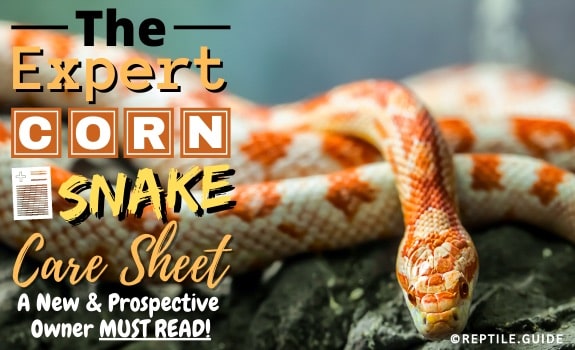Also known as the red rat snake, corn snakes make excellent pets for all levels of herp enthusiasts. But, as with all reptiles, you’ll want to ensure you provide your corn snake care that will allow it to live a long life.
A unique-looking snake, corn snakes come in a variety of color morphs (opens in new tab) with checkered bellies.
They’re also nonvenomous, mild-mannered in nature, and easy to care for, making them an ideal reptile for beginners, while more advanced snake owners strive to breed rare color morphs.
What You’ll Learn In This Corn Snake Care Sheet:
- Background information on the corn snake
- Where to buy a healthy corn snake (plus what to look for!)
- Proper diet for all ages
- How to properly set up a corn snake enclosure
- Health concerns to be aware of (plus how to prevent them!)
- Handling & bonding tips
- & So much more!
Please note that corn snakes are illegal or restricted to keep as pets in certain states within the United States. Check your local laws before buying a pet corn snake or moving to a new state with one in your possession.
If you’re fortunate enough to live in a state that allows corn snake ownership, you’re in luck!
Before heading out to purchase your first corn snake, or a unique color morph to add to your collection, check out this in-depth corn snake care sheet to help your reptile friend live their best life!
In This Article
Corn Snake Background Information
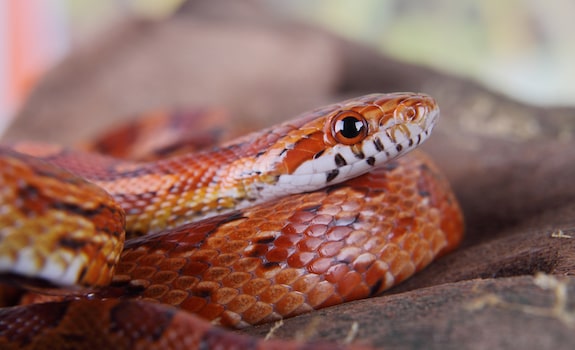
Native to the U.S., corn snakes are found in woodland and forest regions of the southeastern and central United States, as far west as Kentucky and Louisiana, and as far south as Mexico.
Pet corn snakes may be wild-caught, but most are captive bred, which allows for many unusual color morphs.
The standard color of wild corn snakes ranges from orange to gray. Patterns appear in orange, brown, or red with black borders on the back and sides. The belly is checkered black and white, and the underside of the tail is usually striped. In captivity, albinos and many color morphs are produced.
When newly hatched, corn snakes measure between 8 to 12 inches, while adults can reach 3 to 6 feet in length. Generally, males are shorter than their female counterparts.
Despite their length, they are relatively slender, only weighing in at 1 to 2 pounds.
Corn snakes reach adulthood around 3 to 4 years old, and with good care, they can live long lives—15 to 25 years. Some have even lived as long as 30 years!
🔑 Corn Snake Background Key Takeaways: A native snake of the U.S., the corn snake’s natural habitat includes the woodlands and forests of the southeastern and central areas of the country. Growing between 3 to 5 feet in length, this slender snake weighs in between 1 and 2 pounds. With proper care, they can be expected to live between 15 to 25 years!
Corn Snake Costs
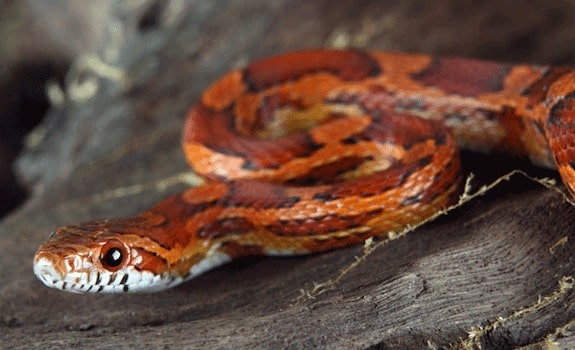
While corn snakes seem unique and pricey, they’re actually quite affordable, and the cost of the snake itself is just a small percentage of the overall startup fee.
For a healthy corn snake from a reputable breeder, prices begin around $50 for the standard color pattern. The more unusual and rare the color morph, the more the price tag increases, up to as much as $500 for a baby blood red scaleless corn snake.
In addition to the cost of your new snake, you must also consider the costs of a proper habitat and diet…
In general, you can expect to spend a minimum of $300 for an adequate enclosure, substrate, lighting, heating, rocks and decor, and fresh-frozen mice.
However, if you have cash to spare, your bill can quickly add up to $1000 for the coolest snake setup on the block.
Where to Buy a Corn Snake
As with any reptile, you’ll want to seek a reputable breeder known for providing excellent care and reasonable prices.
Avoid pet stores, as many fail to train their employees in the specialized ways to properly care for these unique pets, and your new corn snake may be hiding serious diseases that can be difficult and costly to treat.
Instead, search for online breeder reviews, or visit a reptile expo to meet with breeders and meet the snakes in person.
Depending on the rarity of the morph type, you can expect to pay between $40 and $750 for a baby corn snake.
🔑 Corn Snake Purchasing Key Takeaways: A relatively affordable snake, corn snakes can cost on average between $50 and $500 depending on their morph. You’ll do best to search for a reputable breeder in your area or visit a reptile expo and skip pet stores. Expect to spend at minimum $300 on their habitat setup.
Corn Snake Diet and Feeding Guidelines
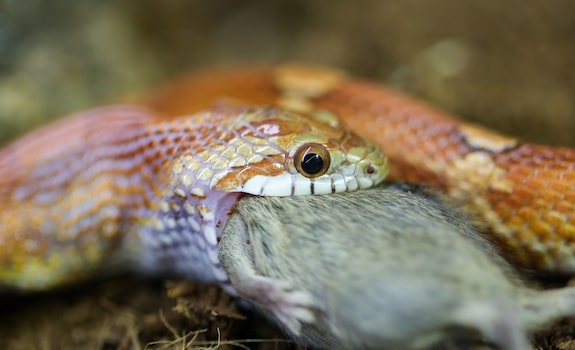
Depending on the size of your snake and their prey, you’ll most likely spend very little to fulfill their dietary needs.
Your weekly cost will typically be just a few dollars, if that, depending on your source and if shipping is necessary.
Components of a Corn Snake Diet
A crepuscular species, corn snakes peak hours of activity are around dawn and dusk. In the wild, these hours are spent hunting prey like small mammals, frogs, fish, and birds.
Because they don’t have hands to help them subdue prey, corn snakes use their teeth and powerful constricting muscles to squeeze their meal until it passes out.
Captive corn snakes are generally fed a diet of mice and rats, and can be fed less frequently the older and larger they become.
Corn snakes may also be offered quail eggs and Reptilinks as an occasional treat.
With a diet of captive-bred mice and rats, there’s a risk of your snake developing nutrient deficiency over time, since captive rodents are thought to be less nutritious than wild rodents.
Fill in the gaps in your snake’s diet by occasionally lightly dusting prey items with calcium or vitamin supplements.
How to Feed Your Corn Snake Based On Age
A good rule to remember when feeding your corn snake is to ensure you don’t offer any prey item larger than 1.5 times the diameter of your snake.
Rough feeding guidelines based on your snake’s age offer an excellent starting point, but these guidelines are not set in stone.
Here is a rough idea of how much to feed your corn snake based on age:
- Hatchling to 2 months: 1 pinkie
- 4 months: 2 pinkies
- 6 months: 3 pinkies
- 8 months: 1 fuzzy
- 10 months: 2 fuzzies
- 12 months: 3 fuzzies
- 14 months: 1 small mouse
- 16 months: 2 small mice
- 18 months: 1 adult or jumbo mouse
Hatchlings should be fed once every 7 days, juveniles should be fed once every 7 to 14 days, and adults should be fed once every 14 to 21 days.
Choose a feeding schedule that offers healthy growth to your young snake, or what keeps an adult at a consistent weight.
Weighing your snake weekly with a kitchen scale will help you determine what works best, as well as track trends in growth or weight loss.
🔑 Corn Snake Diet Key Takeaways: With an extremely affordable diet, it’s easy to keep a corn snake of all ages fed. However, owners will be wise to implement a calcium and/or vitamin supplement to ensure the diet of their pet is well rounded. With hatchlings being fed once a week, juveniles every other week, and adults every 2 to 3 weeks, corn snakes provide an excellent pet choice for those who travel often.
Corn Snake Habitat and Tank Setup
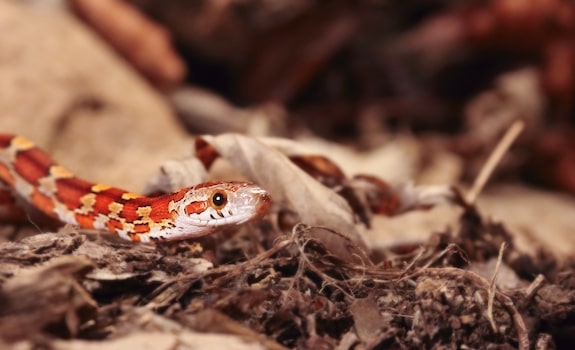
A vital component to your snake’s overall health, maintaining and establishing an appropriate habitat can mean the difference between life and death!
As such, be sure to appropriately plan out every detail prior to adopting your pet. Or, if you already have them, immediately adjust your current tank setup as needed.
Size of the Enclosure
At a minimum, your adult corn snake should be housed in a 30-gallon aquarium, but the more room, the better.
As they age, these snakes become more curious and active, thriving with vertical space to exercise their climbing abilities. They also enjoy burrowing, so a tall enclosure with a thick substrate layer and climbing space is essential.
Type of Enclosures
Many people house their corn snakes in glass aquariums, which can create a nice home, provided that 3 of the 4 glass walls are blocked out to grant your snake privacy and security.
If you choose a glass aquarium, ensure you also purchase a tight-fitting screened lid, as these snakes are master escape artists.
Another excellent option for your snake’s enclosure is a front-opening terrarium. This enclosure is a popular option because it’s secure, easy to access, and holds heat and humidity well.
Ideal Temperature Gradient
To keep your corn snake comfortable, offer three temperature zones that allow easy movement between.
Appropriate temperatures for these zones include:
- Basking surface: 90°F
- Ambient (air temp): 78-82°F
- Cool zone: 75°F
At night, temperatures can safely fall to 68°F, which can be maintained with a ceramic heat emitter if necessary.
A winter cool-down or “brumation” is recommended for healthy snakes only and is required for successful breeding.
Ideal Humidity Levels
Your corn snake enclosure should have an average of 40% to 50% humidity. Keep a close eye on the humidity level in the enclosure and adjust as needed.
Some good ways to increase humidity in your snake’s enclosure would be to add a moist hide or place the water bowl over the under-tank heating element.
Without appropriate humidity, your corn snake may fail to shed fully, or develop respiratory infections in a too-humid environment.
Lighting Requirements
Just as there is bright daylight in the wild, corn snakes need a distinct day/night cycle in captivity as well.
If your snake is housed in a dark room with few windows, add lighting to allow for 12 hours of “daylight” per day.
Wild corn snakes are exposed to varying levels of UVB wavelengths during the day. Conventional wisdom dictates that UVB is not required for most snakes, but recent studies suggest that UVB can be beneficial for a snake’s mental and physical health.
⭐️ Fun Fact: Did you know, early European settlers encountered corn snakes in their cornfields and corn cribs, concluding that they were eating their crops? Little did they know, the snakes were actually doing those farmers a favor by eating the rodents that would otherwise feast on the corn, but the name “corn snake” stuck.
Substrate
In addition to climbing, corn snakes love to hide and burrow into their substrate, so pack a thick layer of your substrate of choice for your snake’s happiness.
The following substrates maintain humidity and allow your snake to burrow to their heart’s content:
- Aspen shavings or chips
- Cypress mulch
- Coconut fiber
- Orchid bark
Keep in mind that pine and cedar substrates cause neurological issues in reptiles, so avoid using pine and cedar shavings or wood chips.
Decor & Accessories
Providing environmental enrichment for your corn snake is a great way to encourage exercise and maintain your pet’s health and happiness.
Some excellent options for your snake’s decor include:
- Heavy water dish – While corn snakes need a water source, place a large, heavy, ceramic-style dish in the enclosure. Aside from fulfilling their drinking needs, corn snakes also like an occasional soak, which helps facilitate shedding.
- Hides – Corn snakes need at least 2 hides, one on the warm side, and another on the cool side. Even though they’re curious and active snakes, they still need a dark, safe place to snooze during the day. You can also provide an additional humid hide on the warm side, packing with damp sphagnum moss to be used as needed for easier shedding.
- Climbing branches – climbing branches allow your snake a great mini source of exercise and will have them enjoying an activity they would enjoy in the wild.
- Fake or organic live plants – Depending on if your desired level of maintenance, real or fake plants can add a beautiful touch to the enclosure and stimulate your pet’s sense with new textures and smells.
🔑 Corn Snake Habitat Key Takeaways: Requiring at minimum a 30 gallon tank, corn snakes must have a clear day to night schedule with a bright white light, but can also benefit from UVB. You’ll need to establish 3 temperature zones as well, ambient temperature (78-82°F), a basking surface (90°F), and a cool zone (75°F). Aim for humidity levels of 40-50%. Choose a substrate they can easily burrow in like aspen shavings/chips or cypress mulch, and be sure to add a water dish, at least 2 hides, plants, and climbing branches.
Corn Snake General Health Information
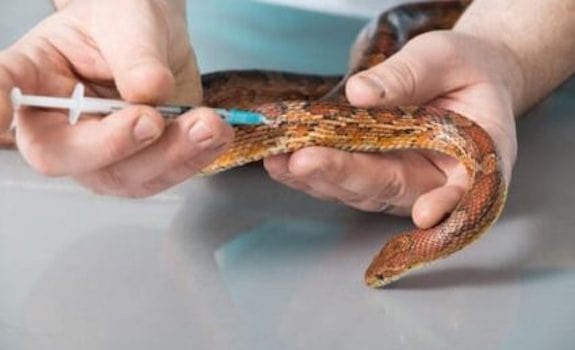
The good news when it comes to corn snakes is that they are relatively hardy. This is because they’re pretty easy to care for and don’t have as finicky of a husbandry setup as other reptiles.
However, as with all reptiles, they are prone to specific health concerns. And this is especially common when their husbandry is poor.
Below are 2 of the MOST common ailments they can fall victim to.
Dysecdysis
Dysecdysis is a fancy word for a “poor shed”.
Retained shed and eye caps can be caused by low humidity, inadequate water for soaking, handling during the blue phase of shedding, and low temperatures.
Stuck shed should always be addressed immediately, as it can harden and restrict blood flow to the area, sometimes causing permanent injury.
Never pull stuck shed off without soaking beforehand.
Pustular dermatitis
Pustular dermatitis goes by many names, including blister disease and scale rot.
Named for the numerous small, blister-like lesions that pop up on the underside of snakes, these blisters can become infected and may progress to skin damage, septicemia, and death.
Snakes who are kept in environments that are too moist and/or dirty are most at risk for scale rot, but conditions without adequate humidity can lead to retained shed and bacterial infection development from debris building up under the retained skin pieces.
Fortunately, there are cheap, at home remedies for scale rot that work surprisingly well. The main thing will be to know the signs as early detection is key.
🔑 Corn Snake Health Key Takeaways: As with all reptiles, even the hardy corn snake is susceptible to specific ailments, namely problems with shedding and scale health. By keeping their enclosure clean, humidity levels and temperatures where they should be, and practicing proper handling during periods of shedding, you can greatly reduce your pet’s risk of suffering from either of these avoidable conditions.
Corn Snake Handling and Bonding Tips
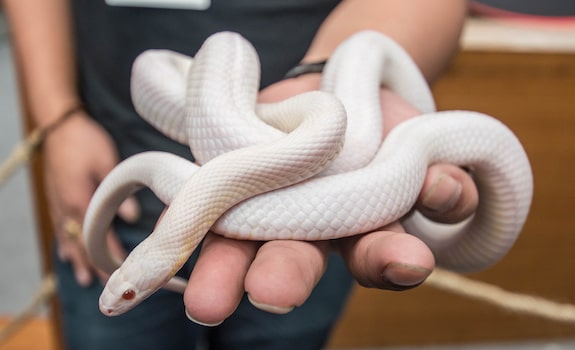
You will need to wait a little while after bringing your new pet home to let them settle in. This usually takes about 2 weeks, but you shouldn’t start handling until your corn snake is eating regularly.
Once your corn snake is ready for handling, take it slow at first. Start with brief handling sessions no longer than 5 minutes, and gradually work up to half an hour. Handling sessions should not exceed 1 hour, as the snake will get too cold.
Before you pick up your corn snake, make sure they’re awake by gently tapping it with a paper towel roll. This will help it realize that it’s handling time, not food time.
Once its tongue starts flicking, you’ll know that the snake is awake.
Use your hands to approach your snake from the side—approaching from above may trigger a defensive instinct.
As you pick your pet up, hold as much of the body as you can, and avoid grabbing the tail or restraining the head.
Corn snakes like to explore, so expect your pet to start climbing up your arms. Many like to drape themselves around their owner’s neck.
Avoid handling your snake within 48 hours of eating or during shedding.
🔑 Corn Snake Handling & Bonding Key Takeaways: Corn snakes are incredibly friendly and easy to handle, although new owners should expect an adjustment period as their snake acclimates to a new environment. After your snake has taken its first meal and 48 hours have passed, feel free to begin handling by gently lifting it from the side and supporting as much of its body as you can.
Is a Corn Snake Right for YOU?
With the relatively easy care requirements of a corn snake, these reptiles make great pets for first-time snake owners.
For more experienced hobbyists, unusual color morphs and patterns are a delightful draw to this charming snake. To them, we can also recommend the False Water Cobra. If you are looking for another, specifically north-American colubrid species, look at the Blue Racer Snake.
Regardless of your experience level, you can be sure a corn snake will make a wonderful pet, with their active and curious personalities and gorgeous colors and patterns.
You can also check how the corn snake compares to the ball python—another popular beginner snake owner species—to get a better sense of whether it really is the best snake for you.
And now that you’re armed with the knowledge on all things corn snake care, what are you waiting for?!
Start searching for your new reptile today and rest easy knowing you’ve done the proper research beforehand.
